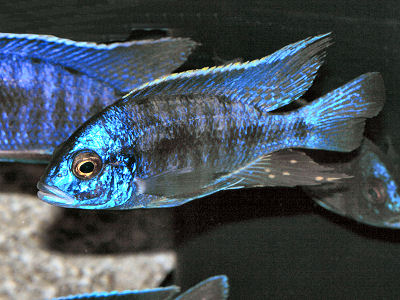
Interesting Facts About Lake Malawi Aulonocara - Peacock Cichlids
Peacock Cichlids are some of the most beautiful African Cichlids you can find.
Interesting Facts About Lake Malawi Aulonocara Cichlids
Peacock cichlids are surpassed in color only by the most superb marine tropical fishes!
The Peacock Cichlids from Lake Malawi are some of the most beautiful cichlids. Their incredible coloring, brilliantly cast in blues, reds and yellows will stop you in your tracks!
It’s no wonder the Aulonocara cichlids are very popular. These attractive Malawi cichlids will breed in captivity with the males displaying exceptional colors.
These fish are members of the free-swimming Haplochromis group and will form schools. Keeping a breeding harem of one or two males with a number of females makes for a spectacular school of aquarium fish. Breeding these beautiful fish is an additional delight of many aquarists.
What is the Peacock Cichlid temperament like?
All of the Haplochromis group are relatively aggressive cichlids, but some more than others. The Peacock Cichlids are one of the more amicable groups. They make great specimens for a large show tank to display their bright colors and iridescence. There are about 28 species and many subspecies to choose from.
Like the lively rock-dwelling Mbuna group, Peacock Cichlids are also quite active but are notably more peaceful. Other Haplochromis members, like the Utaka Cichlids, are elusive and shy enough that they can be kept with the active and more scrappy Mbuna species, as long as there is plenty of space. But Peacock Cichlids are no match for the aggression level demonstrated by the tenacious Zebra Cichlids or other Mbuna, and should not be housed with them.
Peacock Cichlid Habitats
Lake Malawi is one of the two great rift lakes in Eastern Africa, the other being Lake Tanganyika. A long tear in the earth's crust formed millions of years ago as the result of tectonic plates shifting. This vast tear then filled with water to form these two massive, deep, sea-sized lakes along with a number of smaller lakes and ponds.
Lake Malawi is fed by streams that have a high in mineral content, which along with a natural process of evaporation has resulted in highly mineralized, alkaline water. Thus the waters of Lake Malawi are known for clarity and stability as far as pH and other water chemistries.
Peacock Cichlids are endemic to Lake Malawi. This rift lake is estimated to have over 800 species of cichlids. With 213 described species (as of 2007) belonging to the Haplochromis group, this makes it the largest group in the Cichlidae family. Many of the species in this group are endemic to Lake Malawi.
There are two main groups of cichlids from Lake Malawi, the Haplochromines that contain 99% of the fish, and the Tilapiines. The Haplochromines group is further divided into three groups; the rock-dwelling Mbuna group, the Haplochromis open-water browser group, and the Astatotilapia. The Peacock Cichlids of the genus Aulonocara are part of the Haplochromis group of open-water browsers.
The Haplochromis group has a much larger population than the rock-dwelling Mbuna group, which is because they are not bound to isolated rocky regions. Yet the regions in Lake Malawi that these cichlids inhabit - can include rocky areas, sandy areas, and midwater areas, or they can be a combination of two or all three of these types.
Types of Peacock Cichlids
The large Haplochromis group includes the type genus (Haplochromis) plus a number of closely related genera such as the Utaka Cichlids, the beautiful Peacock Cichlids of the genus Aulonocara, and other non-mbuna's.
The term Haplochromis group is used to refer to cichlids that are free-roaming browsers. Peacock Cichlids are members of this group, as are their similar relatives the Utaka Cichlids, and a number of other species. This group is often referred to as "haps" or "happies" in the aquarium industry. Whether Haplochromis itself is a genus or not, is an ongoing debate by the experts.
Included here are various types of Peacock Cichlids.
The beautiful Peacock Cichlids are not only the most colorful fish within the haplochromis group, but are some of the most dazzling freshwater fish in the world. Peacock Cichlids brilliantly are cast in blues, reds, and yellows, with a multitude of color morph variations.
Peacock Cichlids
In the hobby it is extremely difficult to tell exactly which species of Peacock Cichlids you have. This is due not only to multiple variations of the color morphs in nature but also because of much hybridization in captivity. But because Peacocks are a more peaceful group of cichlids the different species can be housed together.
What aquarium is best suited to the Peacock Cichlid?
All Malawi Cichlids are naturally aggressive fish, and when placed in the confines of an aquarium you may see an increase in aggressive behavior. This is especially true if the aquarium is too small, and if there are inadequate places of refuge to avoid an aggressor. Planning ahead can help avoid problems of predation, aggressive incompatibility, and even hybridization.
Peacock Cichlids have an average size of 4-7” (10-18 cm), so need a much larger aquarium than the small rock-dwelling Mbuna group. A minimum size suggested for these fish is 50 gallons, with 100 gallons being better, especially for a community. A good rule of thumb is approximately ½ “ (12 mm) of fish per gallon (4 L). For open swimming species like these, a taller tank is recommended with more open space.
Peacocks are free-swimming cichlids that will form schools in nature, swimming in the water column to feed on zooplankton (they will also eat invertebrates they dig out of the sand). These cichlids are also polygamous, with a male courting several females. So keeping a number of females with one or two males will encourage the formation of schools in the aquarium. If you wish to keep different species together, it also helps to select species that look very different from each other to reduce hybridization.
How to care for your Peacock Cichlid
Other than the need for more open space, the care and maintenance of the Haplochromis group are similar to that of the rock-dwelling Mbunas. Peacock Cichlids will do well with a meaty diet; pellets, frozen and freeze-dried daphnia, bloodworms and brine shrimp are excellent choices. It is always better to feed them small amounts several times a day instead of one large feeding.



Keith butler
Can you mix peacocks with mbunas
Quinta Thompson
What kind of peacock is the green one in the picture?